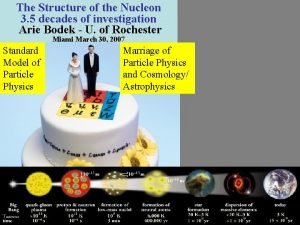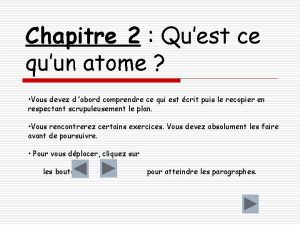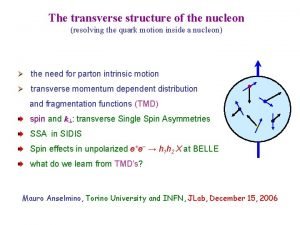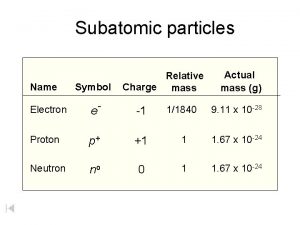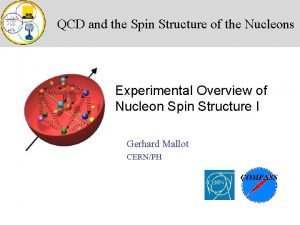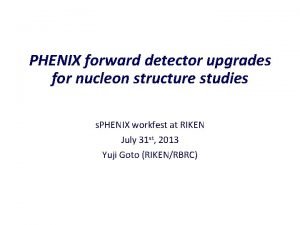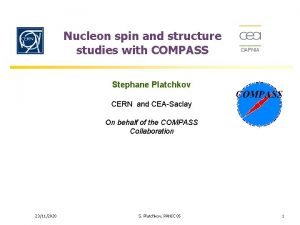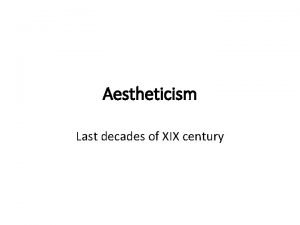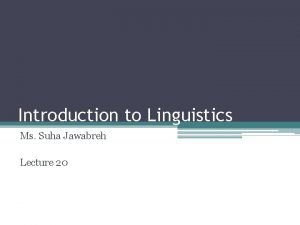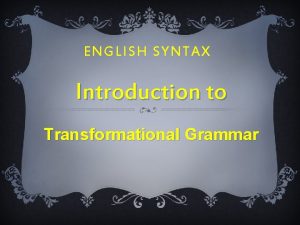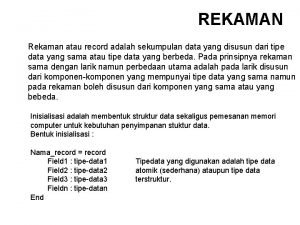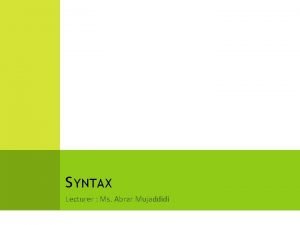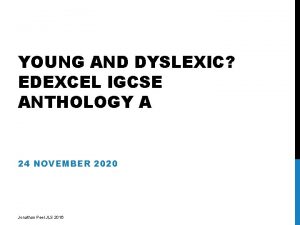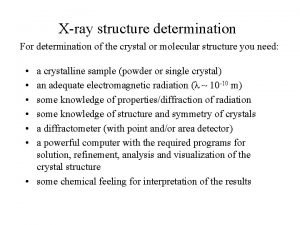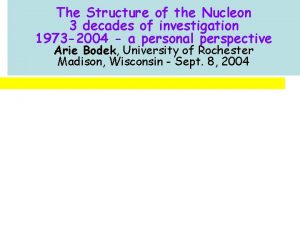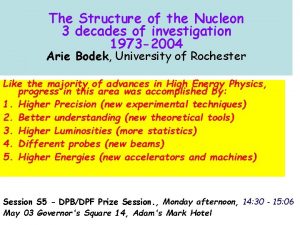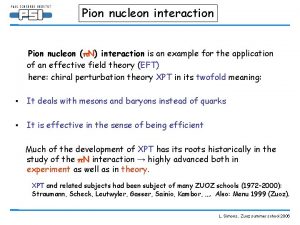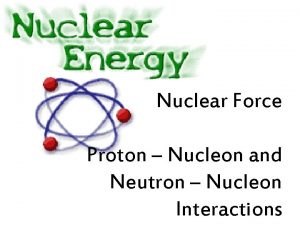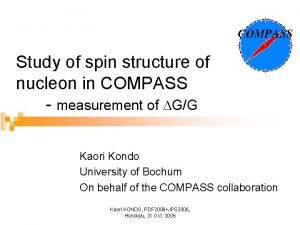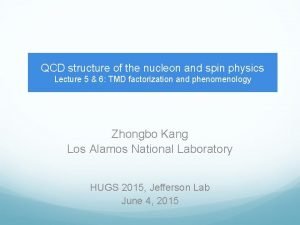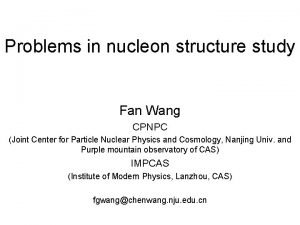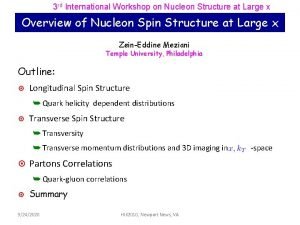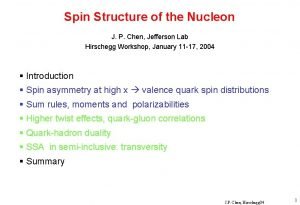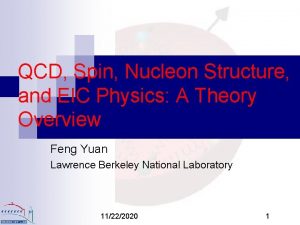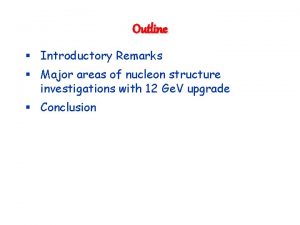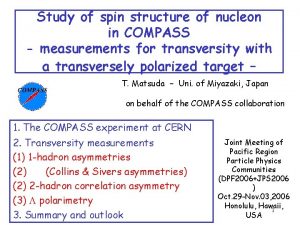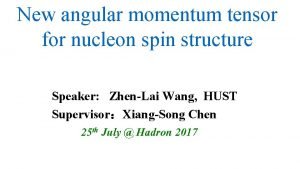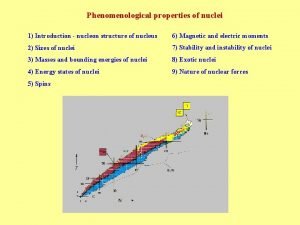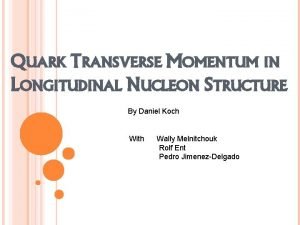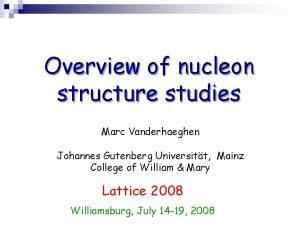The Structure of the Nucleon 3 5 decades















![e-P scattering A. Bodek Ph. D thesis 1972 [ PRD 20, 1471(1979) ] Proton e-P scattering A. Bodek Ph. D thesis 1972 [ PRD 20, 1471(1979) ] Proton](https://slidetodoc.com/presentation_image/956ccca3c564c9b74654d3402427859b/image-16.jpg)

















































- Slides: 65

The Structure of the Nucleon 3. 5 decades of investigation Arie Bodek - U. of Rochester Miami March 30, 2007 Standard Model of Particle Physics Marriage of Particle Physics and Cosmology/ Astrophysics

The Structure of the Nucleon =1 Fermi 10 -15 m =1 fm = 1 Fermi

Standard Model proton mass = 0. 938 Ge. V/c 2

Particle Collisions of Fast moving High Energy Protons - Quantum Chromodynbamics low momentum transfer Q 2 slow moving large momentum transfer Q 2 - fast moving - evolution in Q 2

• 1960 -1968 • ELASTIC Electron Scattering Hofstadter Nobel Prize Proton and neutron have a finite size (about 1 Fermi). Electron or pi, E muon Energy E Proton Target mass M P Q 2=-q 2=square of the four momentum transfer pf, E’ Electron or muon out (lower energy E’) = E - E’ = energy transfer ELASTIC- final state is one Proton with mass W=M INELASTIC- final state is Proton plus pions (Mass W>>M) Feynman diagram

1960 -1968 ELASTIC Electron Scattering Proton and neutron have a finite size (about 1 Fermi)- Form Factors (like optical scattering from a cloudy sphere -inteference) F (q) =Form Factor = Fourier transform of charge distribution Form factor=1 -->point like particle

Interpretation of Form Factors In non-relativistic limit, form factors are Fourier transforms of distributions: Spin 1/2 particles have two elastic electromagnetic form factors: GE : electric form factor GM : magnetic form factor

Calcium Nucleus Form Factor Lead 208 Calcium 40 497 Me. V Falls more steeply 502 Me. V

Calcium Nucleus 4 Fermi Lead Nucleus 6 Fermi

Scattering from Protons and Neutrons Experiment snows a Dipole Form Factor GEp, GMp and GMn roughly follow the Dipole Form Factor. The 0. 71 Ge. V is determined from a fit to the world’s data. An Exponential distribution has dipole form factor: We find

Proton form factors Ratio to Dipole Current status 2007 exponential charge and magnetic distributions Gep Gmp Proton form factors ratio to dipole

Neutron form factors ratio to dipole - current status -2007 Electric - Total charge =0 : Positive on inside, negative on outside Magnetic distribution- exponential. Gen Gmn Neutron form factors ratio to dipole Neutron charge densities

Why do theorists like this experiment so much? - Victor Weisskopf Electron scattering SLAC MIT 1968 -1974 - my Ph. D thesis experiment 13

14

Inelastic scattering: Resonance region pi, E pf, E’ P Electron out(lower energy E’) = E - E’ = energy transfer Q 2=-q 2=square of the four momentum transfer in Ge. V 2 W=1. 238 Ge. V x =Q 2 / (2 M ) INELASTIC- final state is Proton plus pions (Mass W >>M = 0. 938 Ge. V
![eP scattering A Bodek Ph D thesis 1972 PRD 20 14711979 Proton e-P scattering A. Bodek Ph. D thesis 1972 [ PRD 20, 1471(1979) ] Proton](https://slidetodoc.com/presentation_image/956ccca3c564c9b74654d3402427859b/image-16.jpg)
e-P scattering A. Bodek Ph. D thesis 1972 [ PRD 20, 1471(1979) ] Proton Data Electron Energy = 4. 5, 6. 5 Ge. V Data ‘ The electron scattering data in the Resonance Region is the “Frank Hertz Experiment” of the Proton. V. Weisskopf * (former faculty member at Rochester and MIT) when he showed these data at an MIT Colloquium in 1971 (* died April 2002 at age 93) W=1. 238 Ge. V 16

• Particle Physics pre -1968 simplistic view • Many different models for Hadron Structureproton had a finite size, and there were hadron resonances - easily described mathmatically by the quark model. • Quarks was considered more of a convenient way to model a symmetry rather than real particles (since none were ever observed and they had strange properties like 1/3 charge. • “Real Particle Physics” were done at hardon machine where “Resonances” and new particles were being studied and discovered (spectroscopy, group theory, partial wave 17 analysis, resonances, Regge poles etc. )

Deep Inelastic Scattering (DIS): Large Q 2 large (using proton mass = 0. 938 Ge. V as a scale) low Q 2 pf, E’ Q 2=0. 07 Q 2=0. 22 pi, E P Electron out(lower energy E’) = E - E’ = energy transfer Q 2=-q 2=square of the four momentum transfer in Ge. V 2 x =Q 2 / (2 M ) High Q 2=0. 85 Q 2=1. 4 Q 2=3 Q 2=9 Q 2=15 Q 2=25

Q 2 1968: Surprise at W>2 Ge. V


Bjorken SCALING First pointed out by Feynman) mf=mf =0 light pointlike partons Proton is composed of point-like partons with very small mass P. q in the laboratory = M --> x =Q 2 / (2 M ) (Feynman)

Deep Inelastic Scattering ‘ The electron scattering data in the Deep Inelastic Region is the “Rutherford Experiment” of the proton’ Proton is composed of point like particles with very small mass Carrying a fraction x =Q 2 / (2 M ) of the proton momentum when the proton is viewed in a fast moving frame. The proton structure function is only be a function of x (scaling) What do the Frank Hertz” But what are those partons? and “Rutherford Experiment” of the proton’ have in common? Are they quarks? A: Quarks! And QCD

(1) What are the Parton Charges? (2) What are the Parton Spin • 1968 - SLAC e-p scaling ==> Point like Partons in the nucleon (Bjorken/Feyman) MIT-SLAC group: Led by Friedman, Kendall, Taylor. (1) Neutron/Proton ratio - Partons are fractionally charged like quarks (Bodek Ph. D. MIT 1972) • A. Bodek et al. , COMPARISONS OF DEEP INELASTIC ep AND en CROSS-SECTIONS. Phys. Rev. Lett. 30: 1087, 1973. (SLAC Exp. E 49) N P =d d u + sea 1/3 2/3 = u u d + sea 2/3 1/3 Large x N/P -> 0. 25 Explained by valence d/u [ (1/3) / (2/3)]2 =1/4 Small x : N/P=1 explained by sea quarks 23

What is the spin of the Partons? Riordan Ph. D Thesis MIT 1973 Electrons scatter by interacting with electric charge of the partons. It the partons have spin, then there is also a much larger magnetic scattering. Compare Ratio of electric scattering / magnetic scattering R= L/ T (small) Partons are spin 1/2 E. M. Riordan, A. Bodek et al. , EXTRACTION OF R = L/ T FROM DEEP INELASTIC e. P AND e. D CROSS-SECTIONS. Phys. Rev. Lett. 33: 561, 1974. A. Bodek et al. , EXPERIMENTAL STUDIES OF THE NEUTRON AND PROTON ELECTROMAGNETIC STRUCTURE FUNCTIONS. Phys. Rev. D 20: 147124 1552, 1979.

• A: Nobel Prize 1990 - Friedman, Kendall, Taylor for their pioneering investigations concerning deep inelastic scattering of electrons on protons and bound neutrons, which have been of essential importance for the development of the quark model in particle physics. " Front row: Richard Taylor, Jerome Friedman, Henry Kendall. Second row: Arie Bodek, David Coward, Michael Riordan, Elliott Bloom, James Bjorken, Roger (Les) Cottrell, Martin Breidenbach, Gutherie Miller, Jurgen Drees, W. K. H. (Pief) Panofsky, Luke Mo, William Atwood. Not pictured: Herbert (Hobey) De. Staebler 25 Graduate students in italics

The Quest for higher Precision (for me) for the next 3. 5 decades starts here 1972 Integral of F 2(x) did not add up to 1. 0. Missing momentum attributed to “gluons”. Like Pauli’s missing energy in beta decay attributed to neutrinos *Gluons were “Discovered” in 1970, way before gluon jets were observed in PETRA. Scatter shows F 2(x, Q 2) as expected from bremstrahlung of gluons by struck quarks in initial of final states. q-q pair gluon quark proton Scaling violations from “gluon” emission seen in 1973 as predicted Quantum Chromodynamics (QCD) but not believed yet. QCD was not 26 an accepted theory.

If scaling violations are from QCD at high Q 2 are Logarithmic --> it is interesting, scaling is only approximate, but is this new theory right? Harvard, Politzer and de. Rujua - log Q 2 If scaling violations are from binding effects at low Q 2 (called higher twist) --> not interesting ----> scaling will become exact at high Q 2 - 1/Q 2 proton quark 27

Similar to QED … except the gauge field carries the charge relative strength Quantum Chromodynamics QCD asymptotic freedom distance energy density, temperature quark-antiquark pair created from vacuum quark “white” proton (confined quarks) Strong color field “white” 0 2 E=mc ! separation(confined “white” proton Energy grows with !!! quarks) 28 Thanks to Mike Lisa (OSU) for parts of this animation

• First observation of Scaling Violations SLAC -Higher Twist or QCD ? ** E. M. Riordan, A. Bodek et al. , TESTS OF SCALING OF THE PROTON ELECTROMAGNETIC STRUCTURE FUNCTIONS Phys. Lett. B 52: 249, 1974. & and A. Bodek et al. , . Phys. Rev. D 20: 14711552, 1979 & **Note: years later we show Higher Twist come from both binding and NNLO QCD – see U. K. Yang, A. Bodek, STUDIES OF HIGHER TWIST AND HIGHER ORDER EFFECTS IN NLO AND NNLO QCD ANALYSIS OF LEPTON NUCLEON SCATTERING DATA ON F 2 AND R 29 L/ T. Eur. Phys. J. C 13 (2000) 241 245.

QCD and quark-parton model Proton uud (Valence) bound with colored gluons and a sea of quark-antiquark pairs which increase with Q 2. All ar bound together by the color force. Neutron ddu (Valence) bound with colored gluons and a sea of quark-antiquark pairs which increase with Q 2. Charge Symmetry Neutron is the same as a Proton, with each u quark replaced with a d quark and each d quark replace with a u quark. 30

"Physics is generally paced by technology and not by the physical laws. We always seem to ask more questions than we have tools to answer. ” Wolfgang K. H. Panofsky • Questions in 1980 -2004 LO QCD, anti-quarks, strange and charm quarks (hadronic charm production), individual PDFs , longitudinal structure function, quarks in nuclei , high statistics electron, muon and neutrino scattering experiments, NLO and NNLO QCD, origin of higher twist corrections, proton-antiproton collisions, W Asymmetry and d/u, Drell-Yan and Z rapidity distributions, application to neutrino oscillations , - A Detailed understanding of Nucleon Structure Required 35 additional years of Experiments at Different Laboratories, New Detectors, Analysis Techniques and Theoretical Tools - AND also sorting out which experiments are right and which experiments are wrong • A. Bodek Panofsky Prize 2004 • "For broad, sustained, and insightful contributions to elucidating the structure of the nucleon, using a wide variety of probes, tools and methods at many laboratories. " 31

1974: Fermilab and CERN, muon and neutrino beams up to 250 Ge. V Because of parity violation, comparisons of neutrino and antineutrino scattering are different for scattering from quarks versus scattering from antiquarks - use it to measure the antiquark distributions in the nucleon 32

NEUTRINOS only scatter from (-1/3) charge quarks (e. g. d, s quarks) And -2/3 charge anti-quarks (e. g. u, c) m- W+ W+ u +2/3 d -1/3 m- d +1/3 u -2/3 m- W+ W+ d +1/3 u +2/3 +4/3 Not possible +5/3 33

Anti-NEUTRINOS only scatter from (+2/3) charge quarks (e. g. u, c quarks) And +1/3 charge anti-quarks (e. g. d, s) m+ m+ W- W- d -1/3 u +2/3 d +1/3 u -2/3 m+ WW- u -2/3 d -1/3 -4/3 not possible Not possible -5/3 34

Neutrinos on quarks Neutrinos on antiquarks weak 35

Low Q 2 What is the composition at High Q 2 By taking sum and difference F 2 (x, Q 2) = x [ q (x, Q 2) + q (x, Q 2) ] (all quarks) x. F 3 (x, Q 2) = x [ q (x, Q 2) - q (x, Q 2) ] (Valence quarks only) 36

37

38

Neutral current charged current Scattering from strange quarks CCFR - Chicago. Columbia. Fermilab- 39 Rochester

neutrino muon 40

C: Dimuon event Strange Quarks in the Nucleon Caltech-Fermilab Later- CCFR (Columbia -Chicago. Fermilab-Rochester) and -Later- Nu. Te. V Neutrino Collaborations at Fermilab LAB E. The Strange Sea Antiquarks are about 1/2 of the average of u and d sea - Sea is not SU 3 Symmetric. 41

Strange Quarks in the Nucleon - (Caltech-Fermilab, later CCFR Columbia -Chicago-Fermilab-Rochester) and Nu. Te. V Neutrino Collaborations at Fermilab Karol Lang, AN EXPERIMENTAL STUDY OF DIMUONS PRODUCED IN HIGH-ENERGY NEUTRINO INTERACTIONS. UR-908 (1985) Ph. D. Thesis (Rochester) Now Professor at UT Austin K. Lang et al. (CCFR-Rochester Ph. D), NEUTRINO PRODUCTION OF DIMUONS. Z. Phys. C 33: 483, 1987 (leading order analysis) The Strange Sea Anti-quarks are about 1/2 of the average of u and d sea - not SU 3 Symmetric. A. O. Bazarko et al. , (CCFR-Columbia Ph. D) DETERMINATION OF THE STRANGE QUARK CONTENT OF THE NUCLEON FROM A NEXT-TO-LEADING ORDER QCD ANALYSIS OF NEUTRINO CHARM PRODUCTION. Z. Phys. C 65: 189 -198, 1995 M. Goncharov et al. (Nu. Te. V K. State Ph. D). PRECISE MEASUREMENT OF DIMUON PRODUCTION CROSSSECTIONS IN MUON NEUTRINO FE AND MUON ANTI-NEUTRINO FE DEEP INELASTIC SCATTERING AT THE TEVATRON. Phys. Rev. D 64: 112006, 2001 42

Precision Neutrino Experiments REQUIRE good Hadron Calorimetry and Muon Energy calibration (~0. 3%) 10 cm Fe Sampling, simultaneous neutrino running and hadron and muon test beams D. A. Harris, J. Yu et al( Nu. Te. V-Rochester. FNAL) PRECISION CALIBRATION OF THE NUTEV CALORIMETER. UR-1561 Nucl. Inst. Meth. A 447 (2000) W. K. Sakumoto et al. (CCFR-Rochester), CALIBRATION OF THE CCFR TARGET CALORIMETER. Nucl. Instrum. Meth. A 294: 179 -192, 1990. Developed Fe-scintillator compensating calorimeter. 3 mx 3 m large counters with wavelength shifting readout 43

W. G. Seligman et al. (CCFR Columbia Ph. D), IMPROVED DETERMINATION OF 44 S FROM NEUTRINO NUCLEON SCATTERING. Phys. Rev. Lett. 79 (1997) 1213 -1216.

Valence quarks H. Kim (Columbia Ph. D) et al. D. Harris et. al. , (CCFR) MEASUREMENT OF S (Q 2) FROM THE GROSS- LLEWELLYN SMITH SUM RULE. Phys. Rev. Lett. 81 (1998) 45 3595 -3598

Why go for more precision ? To within 15%, theory of Quantum Chromodynamics was confirmed ---> Nobel Prize 2004 (Gross- Politzer -Wilczek) The various quark, anti-quark and gluon distributions were measured to 10%-15% precision (not in all regions) ---> Why do better? It turns out, we really needed to do better at high energies We also needed to do better at low energies. 46

Proton-Antiproton Collisions at very high energies Beamline High Energy- Proton-Antiproton (CDF/Dzero) collisions are actually parton-parton collisions (free nucleons). All searches for new physics require a detailed understanding of the 47 parton structure of the proton.

High Energy- Proton-Antiproton (CDF/Dzero) collisions are actually parton-parton collisions (free nucleons) All experiment in hadron colliders are limited by the knowledge of parton distribution functions (PDF’s) 48

Precision Neutrino Experiments CCFR/Nu. Te. V Un Ki Yang UR-1583, 2000 Ph. D. Thesis, (Rochester) Lobkowicz Prize, U of R; URA Best Thesis Award Fermilab 2001 (now at Univ. of Chicago) Comparing muon and neutrinos Un-Ki Yang et al. . MEASUREMENTS OF F 2 AND XF 3 FROM CCFR MUON NEUTRINO-FE AND MUON ANTI-NEUTRINO-FE DATA IN A PHYSICS MODEL INDEPENDENT WAY. By CCFR/Nu. Te. V Phys. Rev. Lett. 86: 2742 -2745, 2001 49

• Quark Distributions in Nuclei A. Bodek et al Phys. Rev. Lett. 51: 534, 1983 (SLAC Expt. E 49, E 87 empty tgt data 1970, 1972) 50

Back to SLAC using High Energy Beam and the Nuclear Physics Injector NPAS - SLAC E 139, E 140 x, E 141, NE 8 R. G. Arnold et al. , MEASUREMENTS OF THE ADEPENDENCE OF DEEP INELASTIC ELECTRON SCATTERING FROM NUCLEI Phys. Rev. Lett. 52: 727, 1984; J. Gomez et al. , MEASUREMENT OF THE A-DEPENDENCE OF DEEP INELASTIC ELECTRON SCATTERING. Phys. Rev. D 49: 4348 -4372, 1994. 51

Sridhara Rao Dasu, PRECISION MEASUREMENT OF X, Q 2 AND A-DEPENDENCE OF R = L/ T AND F 2 IN DEEP INELASTIC SCATTERING. UR-1059 (Apr 1988). Ph. D. Thesis. (Rochester) SLAC E 140 - winner of the Dexter Prize U of Rochester 1988 (now Professor a U. Wisconsin, Madison) S. Dasu (Rochester Ph. D )et al. , MEASUREMENT OF THE DIFFERENCE IN R = L/ T, and A/ D IN DEEP INELASTIC ed, e. FE AND e. Au SCATTERING. Phys. Rev. Lett. 60: 2591, 1988; S. Dasu et al. , PRECISION MEASUREMENT OF R = L/ T AND F 2 IN DEEP-INELASTIC ELECTRON SCATTERING. Phys. Rev. Lett. 61: 1061, 1988; Anchor all high energy experiment to new very precise measurements at SLAC S. Dasu et al. , MEASUREMENT OF KINEMATIC AND NUCLEAR DEPENDENCE OF R = L// T IN DEEP INELASTIC ELECTRON SCATTERING. Phys. Rev. D 49: 5641 -5670, 1994. L. H. Tao (American U Ph. D) et al. , PRECISION MEASUREMENT OF R = L/ T ON HYDROGEN, DEUTERIUM AND BERYLLIUM TARGETS IN DEEP INELASTIC ELECTRON SCATTERING. Z. Phys. C 70: 387, 1996 L. W. Whitlow (Stanford Ph. D), et al. , A PRECISE EXTRACTION OF R = L/ T FROM A GLOBAL ANALYSIS OF THE SLAC DEEP INELASTIC ep AND ed SCATTERING CROSS-SECTIONS. Phys. Lett. B 250: 193 -198, 1990. L. W. Whitlow, et. al. , PRECISE MEASUREMENTS OF THE PROTON AND DEUTERON STRUCTURE FUNCTIONS FROM A GLOBAL ANALYSIS OF THE SLAC DEEP INELASTIC ELECTRON SCATTERING 52 CROSS-SECTIONS. Phys. Lett. B 282: 475 -482, 1992.

Provided normalization and shape at lower Q 2 for all DIS experiments 53

F 2, R comparison of NLO QCD+TM black (Q 2>1) Un-Ki Yang, A. Bodek Phys. Rev. Lett. 82: 2467 -2470, 1999 vs. NLO QCD+TM+HTgreen (use QCD Renormalons for. HT) NLO QCD + Target Mass + Renormalon HT works. ALSO a GREAT QCD TRIUMPH PDFs and QCD in NLO + TM + QCD Renormalon Model for Dynamic HTdescribe the F 2 and R data very well, with only 2 parameters. Dynamic HT effects are there but small 54

NNLO QCD+TM black Great Triumph of NNLO QCD Un-Ki Yang, A. Bodek. Eur. Phys. J. C 13: 241 -245, 2000 NNLO QCD+Tgt Mass works very well for Q 2>1 Ge. V 2 Size of the higher twist effect with NNLO analysis is really small (but not 0) a 2= -0. 009 (in NNLO) versus – 0. 1( in NLO) - > factor of 10 smaller, a 4 nonzero For High Statitics Hardon Collider Physics (Tevatron, LHC), the next step is to extract NNLO PDFs. So declare victory PDF Professionals (MRST and CTEQ) make progress towards the next generation NNLO PDF fits for Tevatron and LHC 55

Proton-Antiproton (CDF/Dzero) collisions are actually parton-parton collisions (free nucleons) This is why it is important to know the nuclear corrections for PDFs extracted from nucleons bound in Fe (neutrino) or in D 2 (d versus u), when the PDFs are used to extract information from collider data In 1994 uncertainties in d/u from deuteron binding effects resulted in an error in the W mass extracted from CDF data of order 75 Me. V. By the introduction of new techniques, one can use HADRON COLLIDER data to provide independent constraints on free nucleon PDFs. A. Bodek, CONSTRAINTS ON PDFS FROM W AND Z RAPIDITY DISTRIBUTIONS AT CDF. Nucl. Phys. B, Proc. Suppl. 79 (1999) 136 -138. In 56 *Zeuthen 1999, Deep inelastic scattering and QCD* 136 -138.

W Production at CDF q=2/3 q=1/3 57

58

Need to measure the W Asymmetry at high rapidity where there is no central tracking 59

Qun Fan, Arie Bodek, A NEW TECHNIQUE FOR DETERMINING CHARGE AND MOMENTUM OF ELECTRONS AND POSITRONS USING CALORIMETRY AND SILICON TRACKING. In *Frascati 1996, Calorimetry in HEP*553 - 560 Use silicon vertex detector to extrapolate electron track to the forward shower counters. Compare the extrapolated location to the centroid of the EM shower in a segmented shower counter. Energy of electron determined by the shower counter, Sign is determined by investigating if the shower centeroid is to the left or right of the extrapolated track, All hadron collider physics (Tevatron, LHC) with electrons and positrons can be done better without a central tracker. No Track mis. ID Need Just silicon tracking and segmented EM +HAD calorimetry 60

The d/u ratio in standard PDFs found to be incorrect. Now all new PDF fits include CDF W Asymmetry as a constraint. PDF error on W mass reduced 61 to 10 Me. V by using current CDF data.

Proton-antiproton (CDF/Dzero) collisions-Measurement of d/u in the proton by using the W+- Asymmetry Mark Dickson, THE CHARGE ASYMMETRY IN W BOSON DECAYS PRODUCED IN P ANTI-P COLLISIONS. (1994) Ph. D. Thesis (Rochester). (now at MIT Lincoln Labs) Abe et al. (CDF-article on Rochester Ph. D Thesis) THE CHARGE ASYMMETRY IN W BOSON DECAYS PRODUCED IN P ANTI-P COLLISIONS AT 1. 8 -TEV. Phys. Rev. Lett. 74: 850 -854, 1995 Qun Fan, A MEASUREMENT OF THE CHARGE ASYMMETRY IN W DECAYS PRODUCED IN P ANTI-P COLLISIONS. Ph. D. Thesis (Rochester) (now at KLA-Tenor) Abe et al. (CDF article on Rochester Ph. D Thesis), A MEASUREMENT OF THE LEPTON CHARGE ASYMMETRY IN W BOSON DECAYS PRODUCED IN P ANTI-P COLLISIONS. Phys. Rev. Lett. 81: 5754 - 5759, 1998. 62

With this new technique, one can also significantly reduce the QCD background for very forward Z Bosons. Jinbo Liu, Measurement of d /dy for Drell-Yan e+e Pairs in the Z Boson Region Produced in Proton Anti-proton Collisions at 1. 8 Te. V. UR-1606, 2000 - Ph. D. Thesis (Rochester). (now at Lucent Technologies) T. Affolder et al. (CDF- article on Rochester Ph. D Thesis), MEASUREMENT OF d / d. Y FOR HIGH MASS DRELLYAN E+ E- PAIRS FROM P ANTI-P COLLISIONS AT 1. 8 -TEV. Phys. Rev. D 63: 011101, 2001. NLO QCD describes Z -y distributions better than LO QCD 63

Knowledge of high x PDF is used as input to searches for new Z’ bosons in high-mass Drell-Yan cross sections and Forward. Backward Asymmetry (another use of forward tracking of electrons) Arie Bodek and Ulrich Baur IMPLICATIONS OF A 300 -GEV/C TO 500 -GEV/C Z-PRIME BOSON ON P ANTIP COLLIDER DATA AT 1. 8 -TEV. Eur. Phys. J. C 21: 607 - 611, 2001. T. Affolder et al. (CDF) Measurement of d / d. M and forward backward charge asymmetry for high mass Drell-Yan e+ e- pairs from p anti-p collisions at 1. 8 -Te. V. 64 Phys. Rev. Lett. 87: 131802, 2001

For Te. V Hadron Colliders - The Triumph of NNLO QCD. Conclusion Large Hadron Collider LHC, use a NNLO QCD analysis with Q 2>1 Ge. V 2 DIS data Get better constraints on PDFs from W, Z and Drell Yan data at the Tevatron and LHC. Search for New Physics Higgs, Supersymmetry, etc. LHC Turns on 2008. The fact that the nucleon has a complicated structure is not longer a limitation on the search for new physics at very high energies - nucleon structure at very high energies is well understood and we have the technology to use LHC data to know it to the necessary level of precision. 65 * For very low energies - neutrino oscillations -we develop new and different
 Nucleon
Nucleon M atome = a x m nucleon
M atome = a x m nucleon Nucleon
Nucleon Describe neutrons.location: charge: mass:
Describe neutrons.location: charge: mass: Nucleon
Nucleon Nucleon
Nucleon Nucleon
Nucleon Decades project examples
Decades project examples Last decades art
Last decades art One step forward two decades back
One step forward two decades back Hình ảnh bộ gõ cơ thể búng tay
Hình ảnh bộ gõ cơ thể búng tay Ng-html
Ng-html Bổ thể
Bổ thể Tỉ lệ cơ thể trẻ em
Tỉ lệ cơ thể trẻ em Gấu đi như thế nào
Gấu đi như thế nào Chụp phim tư thế worms-breton
Chụp phim tư thế worms-breton Chúa yêu trần thế alleluia
Chúa yêu trần thế alleluia Kể tên các môn thể thao
Kể tên các môn thể thao Thế nào là hệ số cao nhất
Thế nào là hệ số cao nhất Các châu lục và đại dương trên thế giới
Các châu lục và đại dương trên thế giới Công của trọng lực
Công của trọng lực Trời xanh đây là của chúng ta thể thơ
Trời xanh đây là của chúng ta thể thơ Mật thư anh em như thể tay chân
Mật thư anh em như thể tay chân Phép trừ bù
Phép trừ bù độ dài liên kết
độ dài liên kết Các châu lục và đại dương trên thế giới
Các châu lục và đại dương trên thế giới Thơ thất ngôn tứ tuyệt đường luật
Thơ thất ngôn tứ tuyệt đường luật Quá trình desamine hóa có thể tạo ra
Quá trình desamine hóa có thể tạo ra Một số thể thơ truyền thống
Một số thể thơ truyền thống Cái miệng nó xinh thế chỉ nói điều hay thôi
Cái miệng nó xinh thế chỉ nói điều hay thôi Vẽ hình chiếu vuông góc của vật thể sau
Vẽ hình chiếu vuông góc của vật thể sau Biện pháp chống mỏi cơ
Biện pháp chống mỏi cơ đặc điểm cơ thể của người tối cổ
đặc điểm cơ thể của người tối cổ V. c c
V. c c Vẽ hình chiếu đứng bằng cạnh của vật thể
Vẽ hình chiếu đứng bằng cạnh của vật thể Vẽ hình chiếu vuông góc của vật thể sau
Vẽ hình chiếu vuông góc của vật thể sau Thẻ vin
Thẻ vin đại từ thay thế
đại từ thay thế điện thế nghỉ
điện thế nghỉ Tư thế ngồi viết
Tư thế ngồi viết Diễn thế sinh thái là
Diễn thế sinh thái là Các loại đột biến cấu trúc nhiễm sắc thể
Các loại đột biến cấu trúc nhiễm sắc thể Bảng số nguyên tố
Bảng số nguyên tố Tư thế ngồi viết
Tư thế ngồi viết Lời thề hippocrates
Lời thề hippocrates Thiếu nhi thế giới liên hoan
Thiếu nhi thế giới liên hoan ưu thế lai là gì
ưu thế lai là gì Hươu thường đẻ mỗi lứa mấy con
Hươu thường đẻ mỗi lứa mấy con Khi nào hổ con có thể sống độc lập
Khi nào hổ con có thể sống độc lập Hệ hô hấp
Hệ hô hấp Từ ngữ thể hiện lòng nhân hậu
Từ ngữ thể hiện lòng nhân hậu Thế nào là mạng điện lắp đặt kiểu nổi
Thế nào là mạng điện lắp đặt kiểu nổi Physical state of covalent compounds
Physical state of covalent compounds Giant molecular structure vs simple molecular structure
Giant molecular structure vs simple molecular structure Structural ambiguity
Structural ambiguity Surface and deep structure
Surface and deep structure Subject-dqrnghtp
Subject-dqrnghtp Zinc oxide + nitric acid → zinc nitrate + water
Zinc oxide + nitric acid → zinc nitrate + water Static and dynamic queue in data structure
Static and dynamic queue in data structure Record structure in data structure
Record structure in data structure Deep surface structure
Deep surface structure Trimagenda
Trimagenda Young and dyslexic annotations
Young and dyslexic annotations Poem structure and form
Poem structure and form Single crystal diffractometer
Single crystal diffractometer
